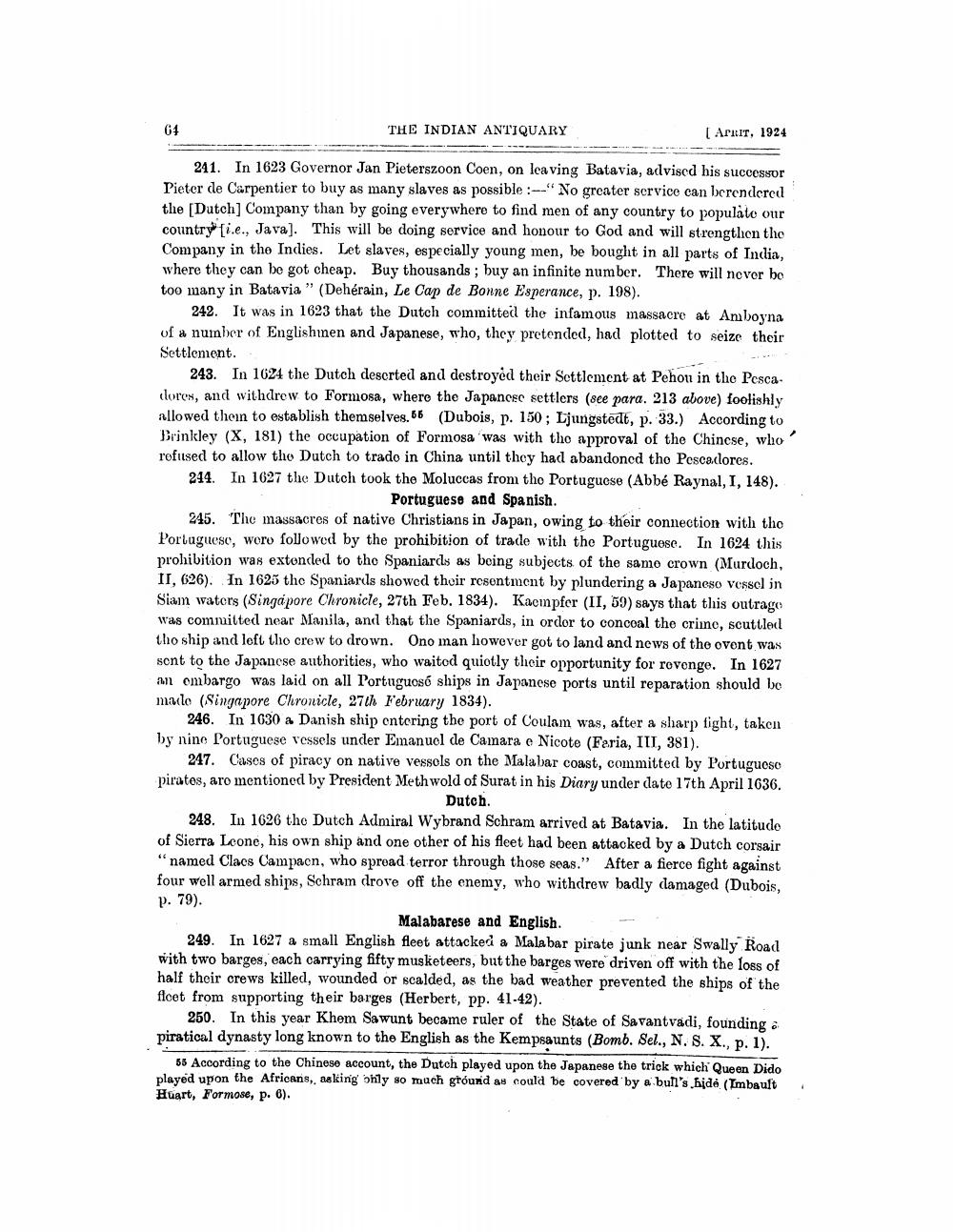________________
THE INDIAN ANTIQUARY
[ Artit, 1924
241. In 1623 Governor Jan Pieterszoon Coen, on leaving Batavia, advised his successor Pieter de Carpentier to buy as many slaves as possible :-"No greater service can berendered the Dutch] Company than by going everywhere to find men of any country to populate our country i.e., Java]. This will be doing service and honour to God and will strengthen the Company in the Indies. Let slaves, especially young men, be bought in all parts of India, where they can be got cheap. Buy thousands ; buy an infinite number. There will never bo too many in Batavia " (Dehérain, Le Cap de Bonne Esperance, p. 198).
242. It was in 1623 that the Dutch committed the infamous massacre at Anboyna of a number of Englishmen and Japanese, who, they pretended, had plotted to seize their Settlement.
243. In 1024 the Dutch desorted and destroyed their Settlement at Pehou in the Pesca dores, and withdrew to Formosa, where the Japancec settlers (see para. 213 above) foolishly allowed thein to establish themselves. 66 (Dubois, p. 150 ; Ljungstedt, p. 33.) According to Brinkley (X, 181) the occupation of Formosa was with the approval of the Chinese, who rofilsed to allow the Dutch to trado in China until they had abandoned tho Pescaclores. 244. In 1627 the Dutch took the Moluccas from tho Portuguese (Abbé Raynal, I, 148).
Portuguese and Spanish. 245. The massacres of native Christians in Japan, owing to their connection with tho Portuguese, word followed by the prohibition of trade with the Portuguose. In 1624 this prohibition was extended to the Spaniards as being subjects of the same crown (Murdoch, II, 626). In 1625 the Spaniards showed their resentment by plundering a Japaneso Vessel in Siam waters (Singapore Chronicle, 27th Feb. 1834). Kaempfer (II, 59) says that this outrago was committed near Manila, and that the Spaniards, in ordor to concoal the crime, scuttlec tho ship and left the crew to drown. Ono man however got to land and news of the ovent was sent to the Japanese authorities, who waitod quiotly their opportunity for revenge. In 1627 an ombargo was laid on all Portuguosó ships in Japanese ports until reparation should be malo (Singapore Chronicle, 27th February 1834).
246. In 1630 a Danish ship entering the port of Coulam was, after a sharp fight, taken by nine Portuguese vessels under Emanuel de Camara e Nicoto (Feria, III, 381).
247. Cases of piracy on native vessels on the Malabar coast, committed by Portugueso pirates, aro mentioned by President Methwold of Surat in his Diary under date 17th April 1636.
Dutch. 248. In 1626 the Dutch Admiral Wybrand Schram arrived at Batavia. In the latitudo of Sierra Leone, his own ship and one other of his fleet had been attacked by a Dutch corsair "named Clacs Campacn, who spread terror through those seas." After a fierce fight against four well armed ships, Schram drove off the enemy, who withdrew badly damaged (Dubois, p. 79).
Malabarese and English. 249. In 1627 a small English fleet attacked a Malabar pirate junk near Swally Road with two barges, each carrying fifty musketeers, but the barges were driven off with the loss of half their crews killed, wounded or scalded, as the bad weather prevented the ships of the fleet from supporting their barges (Herbert, pp. 41-42).
250. In this year Khem Sawunt became ruler of the State of Savantvadi, founding a piratical dynasty long known to the English as the Kempsaunts (Bomb. Sel., N. S. X., p. 1).
55 According to the Chinese account, the Dutch played upon the Japanese the trick which Queen Dido played upon the Africans, asking only so much ground as could be covered by a bull's hidó (Imbault Huart, Formose, p. 6).




